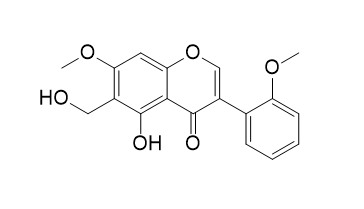CristateinCAS# 919490-61-2 |

Quality Control & MSDS
Package In Stock
Number of papers citing our products

| Cas No. | 919490-61-2 | SDF | Download SDF |
| PubChem ID | N/A | Appearance | Powder |
| Formula | C18H16O6 | M.Wt | 328.3 |
| Type of Compound | Flavonoids | Storage | Desiccate at -20°C |
| Solubility | Soluble in Chloroform,Dichloromethane,Ethyl Acetate,DMSO,Acetone,etc. | ||
| General tips | For obtaining a higher solubility , please warm the tube at 37 ℃ and shake it in the ultrasonic bath for a while.Stock solution can be stored below -20℃ for several months. We recommend that you prepare and use the solution on the same day. However, if the test schedule requires, the stock solutions can be prepared in advance, and the stock solution must be sealed and stored below -20℃. In general, the stock solution can be kept for several months. Before use, we recommend that you leave the vial at room temperature for at least an hour before opening it. |
||
| About Packaging | 1. The packaging of the product may be reversed during transportation, cause the high purity compounds to adhere to the neck or cap of the vial.Take the vail out of its packaging and shake gently until the compounds fall to the bottom of the vial. 2. For liquid products, please centrifuge at 500xg to gather the liquid to the bottom of the vial. 3. Try to avoid loss or contamination during the experiment. |
||
| Shipping Condition | Packaging according to customer requirements(5mg, 10mg, 20mg and more). Ship via FedEx, DHL, UPS, EMS or other couriers with RT, or blue ice upon request. | ||

Cristatein Dilution Calculator

Cristatein Molarity Calculator
| 1 mg | 5 mg | 10 mg | 20 mg | 25 mg | |
| 1 mM | 3.046 mL | 15.23 mL | 30.4599 mL | 60.9199 mL | 76.1499 mL |
| 5 mM | 0.6092 mL | 3.046 mL | 6.092 mL | 12.184 mL | 15.23 mL |
| 10 mM | 0.3046 mL | 1.523 mL | 3.046 mL | 6.092 mL | 7.615 mL |
| 50 mM | 0.0609 mL | 0.3046 mL | 0.6092 mL | 1.2184 mL | 1.523 mL |
| 100 mM | 0.0305 mL | 0.1523 mL | 0.3046 mL | 0.6092 mL | 0.7615 mL |
| * Note: If you are in the process of experiment, it's necessary to make the dilution ratios of the samples. The dilution data above is only for reference. Normally, it's can get a better solubility within lower of Concentrations. | |||||

Calcutta University

University of Minnesota

University of Maryland School of Medicine

University of Illinois at Chicago

The Ohio State University

University of Zurich

Harvard University

Colorado State University

Auburn University

Yale University

Worcester Polytechnic Institute

Washington State University

Stanford University

University of Leipzig

Universidade da Beira Interior

The Institute of Cancer Research

Heidelberg University

University of Amsterdam

University of Auckland

TsingHua University

The University of Michigan

Miami University

DRURY University

Jilin University

Fudan University

Wuhan University

Sun Yat-sen University

Universite de Paris

Deemed University

Auckland University

The University of Tokyo

Korea University
- Guaiacylglycerol 8-O-beta-D-glucopyranoside
Catalog No.:BCX0115
CAS No.:109280-40-2
- Obacunonic acid
Catalog No.:BCX0114
CAS No.:1961237-40-0
- (2R)-3-Hydroxy-2-[4-(3-hydroxypropyl)-2- methoxyphenoxy]propyl beta-D-glucopyranoside
Catalog No.:BCX0113
CAS No.:198817-97-9
- Sequoiaflavone
Catalog No.:BCX0112
CAS No.:21763-71-3
- Neobudofficide
Catalog No.:BCX0111
CAS No.:194602-91-0
- 6-O-Galloylglucose
Catalog No.:BCX0110
CAS No.:13186-19-1
- Isokaempferide 7-rutinoside
Catalog No.:BCX0109
CAS No.:18467-06-6
- 24-epi-7,8-Didehydrocimigenol 3-xyloside
Catalog No.:BCX0108
CAS No.:150972-77-3
- 2-Glucosyloxy-4-methoxycinnamic acid (Z-GMCA)
Catalog No.:BCX0107
CAS No.:31564-49-5
- 4-(2-Hydroxyethyl)benzoic acid
Catalog No.:BCX0106
CAS No.:46112-46-3
- N-trans-p-Coumaroyl-N'-trans-feruloyl-3-hydroxy-cadaverine
Catalog No.:BCX0105
CAS No.:2584997-91-9
- (Z)-Tonghaosu
Catalog No.:BCX0104
CAS No.:4575-53-5
- (2S)-3-Hydroxy-2-[4-(3-hydroxypropyl)-2- methoxyphenoxy]propyl beta-D-glucopyranoside
Catalog No.:BCX0117
CAS No.:198817-98-0
- Apigenin 7,4'-diglucoside
Catalog No.:BCX0118
CAS No.:31737-50-5
- Methyl obacunoate
Catalog No.:BCX0119
CAS No.:751-48-4
- 2-Methoxyphenyl-4-propylene-1-O-beta-apiofuranosyl-(1-6)-beta-glucopyranoside
Catalog No.:BCX0120
CAS No.:2476709-47-2
- Borapetoside A
Catalog No.:BCX0121
CAS No.:100202-29-7
- Quercetin 3-glucosyl-(1->2)-galactoside
Catalog No.:BCX0122
CAS No.:95043-15-5
- Eugenyl O-beta-apiofuranosyl-(1''->6')-O-beta-glucopyranoside
Catalog No.:BCX0123
CAS No.:136083-96-0
- 25-Methoxyalisol F
Catalog No.:BCX0124
CAS No.:2221029-53-2
- 2-Phenylethyl 2-O-beta-D-glucopyranosyl-beta-D-glucopyranoside
Catalog No.:BCX0125
CAS No.:239795-38-1
- cis-5-O-Feruloylquinic acid
Catalog No.:BCX0126
CAS No.:87099-75-0
- Erythro-1',2'-dihydroxyasarone
Catalog No.:BCX0127
CAS No.:146830-05-9
- 11-Deoxyalisol A
Catalog No.:BCX0128
CAS No.:155800-98-9
Phenolic constituents of Celosia cristata L. susceptible to spinach root rot pathogen Aphanomyces cochlioides.[Pubmed:17031042]
Biosci Biotechnol Biochem. 2006 Oct;70(10):2567-70.
Cochliophilin A (5-hydroxy-6,7-methylenedioxyflavone, 1), known as a host-specific attractant towards the zoospores of Aphanomyces cochlioides, a cause of root rot and damping-off diseases of Chenopodiaceae, was found in the Amaranthaceae plant, Celosia cristata, that is susceptible to the pathogen. The content of 1 in Celosia seedlings was quantified as 1.4 microg/g fresh weight. A new isoflavone, Cristatein (5-hydroxy-6-hydroxymethyl-7,2'-dimethoxyisoflavone, 2), and five known flavonoids were also identified.


